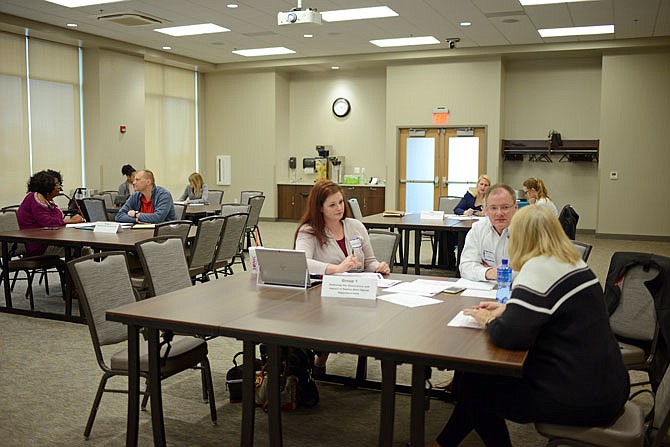Stakeholders from multiple walks of life gathered again Friday for the second Opioid Summit in about six weeks to review plans, share ideas and learn of resources available to help combat the opioid epidemic in the Cole County area.
This time, they were joined through teleconference by members of the community in Washoe County, Nevada - the county where Reno stands.
It was the first time multiple widely separated communities had participated in training intended to overcome a nationwide problem, according to Bill Barberg, who also participated through telecommunications and presented the training from his home in Minnesota.
"We call this a community coalition accelerator," Barberg said, "because we believe that most communities that participate in this have some current activities going on and some things they are getting started to address the opioid, heroin and fentanyl crisis."
If people are making the most of resources available and hitting the crisis at many different levels, they can end it, Barberg said.
Hosted by the Council for Drug Free Youth and Capital Region Medical Center, Friday's summit was part of an ongoing effort to identify ways to intervene in the crisis.
Barberg began the summit by explaining a process to overcome a large challenge, by first breaking the task into smaller components. Early parts of Friday's discussions reviewed information Barberg shared with the Cole County participants in late February. For participants in Nevada, information was new.
"We're not looking for a quick fix here," Barberg said. "We want to get some winners that are fairly quick, but to get some successful changes in our community, you need to be in it for the long haul."
So the coalitions need to find ways to stay organized.
Historically, coalitions like those gathered Friday put together plans, but after a couple of years, with turnover of membership and information drains, participants feel like they need to start over, he said.
"We hope this process we're bringing to you will help you to get better and better in an organized and strategic manner," Barberg said.
A difficulty to overcoming the opioid crisis, he said, is there are so many pathways that lead to non-medical use of the drugs. Many people begin with prescriptions from doctors. Others may have been stuck in despair or depression and started non-medical use, he said. Others self-medicate after trauma or stress. And many are categorized as youths seeking kicks.
"We need many different efforts going on in parallel to address different types of factors that lead to opioid misuse and we need to address them on all levels," he said. "So that can be overwhelming for folks."
It won't be cheap, he added.
Part of the summit focused on helping the coalition identify low-cost strategies that could help them manage the effort financially. He told listeners to look for programs that may be included in the effort.
"You can often get a lot more value by assisting an existing program than launching a new one," Barberg said.
In February, local participants divided into five groups - each focused on a separate topic:
Group 1: Reducing the occurrence and impact of babies born opioid dependent or with neonatal abstinence syndrome.
Group 2: Improving safe storage and disposal of prescription drugs.
Group 3: Enhancing peer recovery groups.
Group 4: Enhancing and expanding screening, brief intervention and referral to treatment.
Group 5: Improving and increasing protective factor to youth.
The groups left February's first summit with topics they were tasked with streamlining and developing action plans. Some were able to begin getting actions underway.
Following Friday's opening remarks by Barberg, Joy Sweeney, executive director of the Council for Drug Free Youth, participated in a break-out session with Group 5. Members of the group discussed improving care for children and outreach to adults who may be able to influence children.
Sweeney said she'd like to see children receive increases in opportunities for recreational activities. But she'd also like to see some changes to children's care.
"To me, improving detection and treatment of mental health conditions is huge," Sweeney said.
Sweeney said the group who attended the event offered a lot of ideas and resources. A challenge, she added, was taking the ideas and turning them into doable actions.
There has already been work completed toward some of Group 2's topics. That group looked at ways to make disposal of unused medications more convenient.
So, with the recent opening of a disposal site in the Capital Region Medical Center pharmacy at 1125 Madison St., there are now three such sites available in Jefferson City. The other two are at Walgreens Pharmacy, 2002 Missouri Blvd., and Roberts Drug Store, 3501 W. Truman Blvd.
During a national drug take-back event April 27, there will be two locations available where people may drop off unused prescriptions for disposal, members of the group said.
One is scheduled for 10 a.m.-2 p.m. at the Jefferson City Police Department, 401 Monroe St., while the location of the second has not been finalized.
Within Group 4, Shelly Lock, who works for Jefferson City Public Schools, reminded others Missouri remains the only state that doesn't have a statewide prescription drug-monitoring program.
"That legislative topic has a huge effect on what we're discussing here," Lock said.
Sweeney said she invited local lawmakers to the summit, but as of early Friday hadn't heard back from them.
Legislators "need to be at these tables," Lock said. "The more information they collect from boots on the ground, the better they'll be able to pass legislation to meet the needs."

